How To Pick A Good Watermelon
Here are six tips for How to Pick a Good Watermelon that’s ripe and sweet, gathered from lots of conversations with produce people, farmers, and personal experience. If you know how to check for things like the field spot, it makes the selection process much easier!
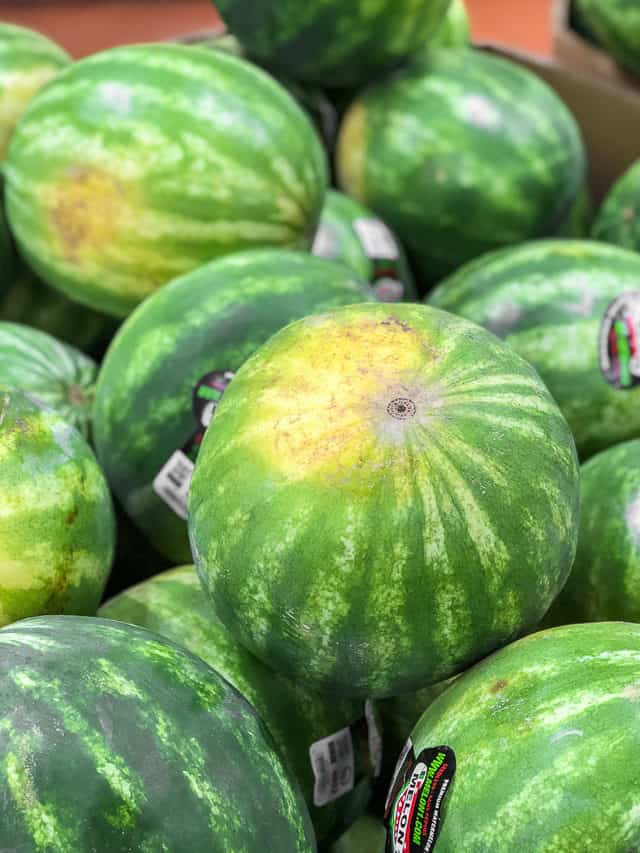
Picking out a perfect watermelon at the grocery store was always a semi-anxiety plagued experience for me when I didn’t know what I was looking for.
If you pick a bad one, you’re stuck with 15-20 whopping pounds of watermelon terribleness. And then your options are to either force yourself to eat this yucky watermelon or throw it away…and both are less than desirable options.
There have been a few times where I ended up throwing it out because it tasted like a crunchy watermelon rind cucumber, and no one in my family would eat it.
My goal today is to help you pick a sweet, ripe watermelon because I know how disappointing it is to get home, take your first bite of some sort of produce you buy, only to find out it isn’t good.
All the tips here are tidbits I have gathered from personal experience and lots of conversations with produce people and farmers. Here’s how to pick the best watermelon!
Tip #1: Find the Field Spot
If you don’t even read the other tips, I find this is the biggest indicator of a good watermelon.
The field spot, or ground spot, is a creamy spot on the outside, and it’s where the watermelon was resting on the ground, or the underside of the watermelon.
The field spot should be a yellowish creamy color, like shown with my watermelon:
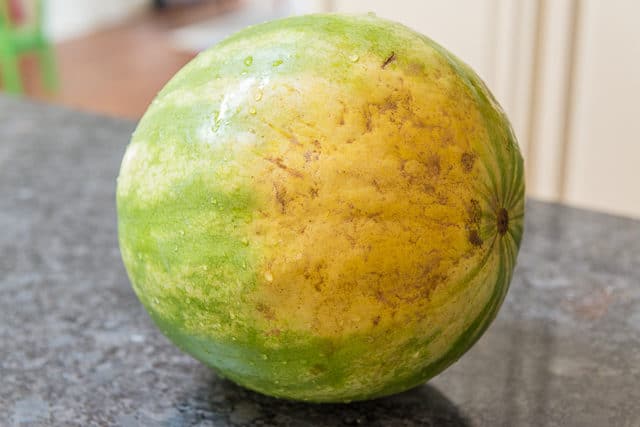
The more dark yellow the field spot is, the longer it was on the vine sweetening up. If the field spot is a white spot (or not even there), this indicates an underripe melon.
What’s interesting is you’ll notice that the other side of the same watermelon looks completely different:
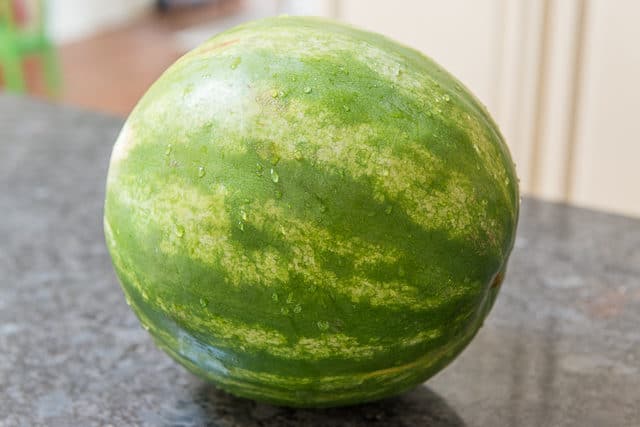
It’s much prettier and more typical of what I picture when I think of a watermelon, and that’s okay.
I find that the best watermelons I buy can sometimes look really gnarly on one side, usually the underside of the melon where it was resting on the ground, and then unblemished on the other. But you don’t want it to look perfectly green all the way around.
Note: It’s fine if there are green stripes, or not, or if there’s solid green color on most of the outside of the watermelon. The exterior pattern is more about the varieties of watermelons that your grocery store carries, and not anything to do with being a ripe melon or not.
Tip #2: Pick a Dull Looking Exterior
A shiny exterior appearance indicates an underripe watermelon, though this can be a bit tricky if they’ve added wax, and then you can’t really tell. This applies to honeydew melons too. Don’t be put off by a dull looking watermelon.
Tip #3: Knock on It with Your Knuckles
Your knuckles should bounce off the melon, and the surface should be pretty hard and firm. You will get a dull thud if the flesh is soft, which indicates it’s starting to spoil. Avoid any melon with soft spots!
Rather than a dull thud, you are looking for a hollow sound, a deep sound. It takes a lot of testing to learn what this sounds like, so don’t use it as your only indicator.
If you don’t want to knock with your knuckles, then you can push firmly with the tip of your thumb. Ideally there should be little or no give when you push in.
Tip #4: Get the Heaviest One for Its Size
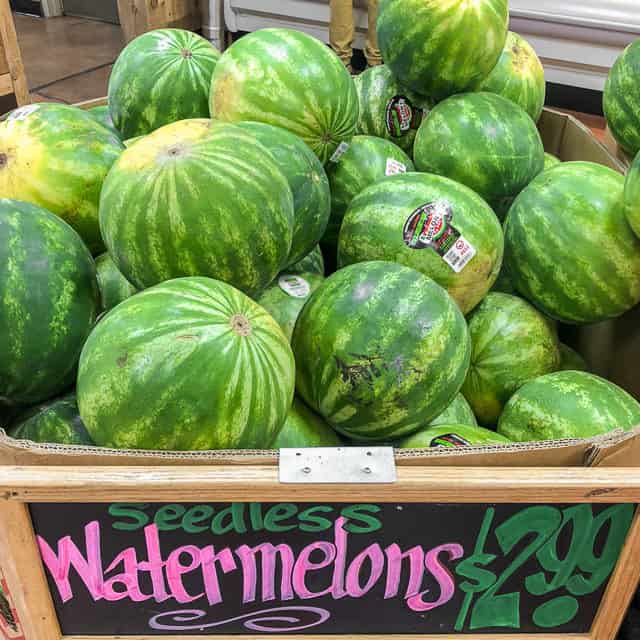
This applies to pretty much all produce, but you want to pick a heavy watermelon, meaning the one that is the heaviest for its size. That means there’s more water in it, which means a juicy watermelon.
The easy way to check for this is to pick up a few melons and compare their weights (or, if there’s a scale nearby, actually weigh them).
The whole watermelon pictured above here in my post was a whopping 18 pounds! It was heavier than the other comparably sized melons around it. It’s more bang for your buck too.
Tip #5: Check for a Uniform Shape
Some watermelons are round, some are oval, and either is fine. They are just different varieties. But if there are irregular bumps, this indicates the melon may have gotten inconsistent amounts of sun or water, and you should avoid that one.
Tip #6: Look for the Sugar Spots and Pollination Points
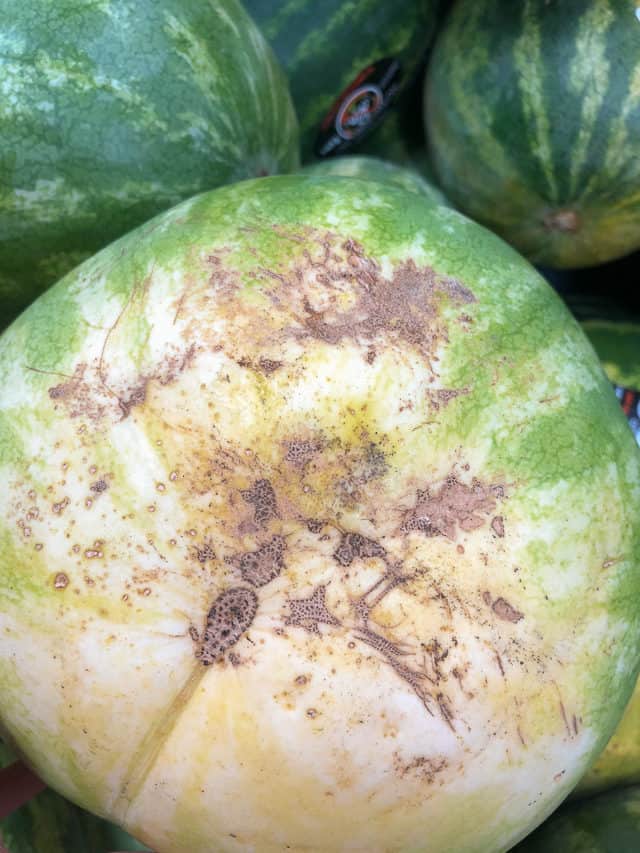
This tip was emailed to me many months ago by Tom, a produce manager for a major grocery chain. If you see black spots on the melon (as pictured above), this is where sugar is seeping out and indicates a sweet melon. At first glance, a sugar spot might just look like dirt, but if it doesn’t rub off easily, then it’s a sugar spot.
Also, if you see dots in a line (not a scratch), these are pollination points, and the more of them the better. I’ve been looking for these every time I pick up a melon and have had great luck with it in addition to the other tips. Thank you, Tom!
Though the above melon did not have a creamy yellow spot (it’s a little white), the sugar spots are a good sign. It was indeed a sweet watermelon.
What about the stem?
I’ve never seen a watermelon with its green stem on, though perhaps you’re more likely to find one at a farmers market. Odds are it won’t come up anyway, but I don’t know if any ripeness indications from the stem.
Once you’ve picked out a good watermelon, take a look at my quick guide for How to Cut a Watermelon, which is how I always cut watermelon to keep in the fridge. But is especially the best way to serve this delicious fruit for parties and entertaining.
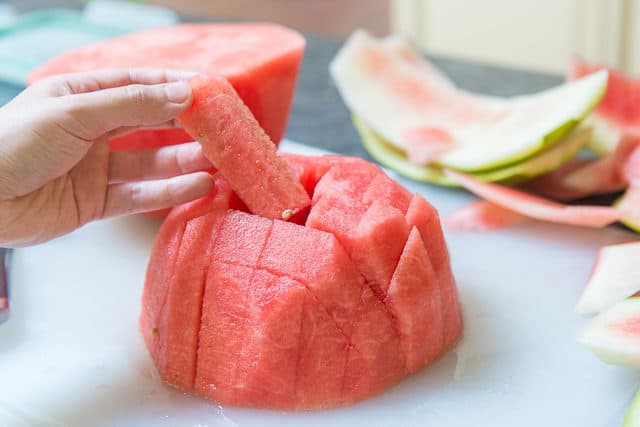
The middle of the watermelon always has the best flavor, so you’ll want to cut away a substantial amount of rind.
This method of cutting is SO much easier than cutting the typical triangles that include the rind, and you can either cut it into sticks or cubes. My perfect slice is actually the stick!
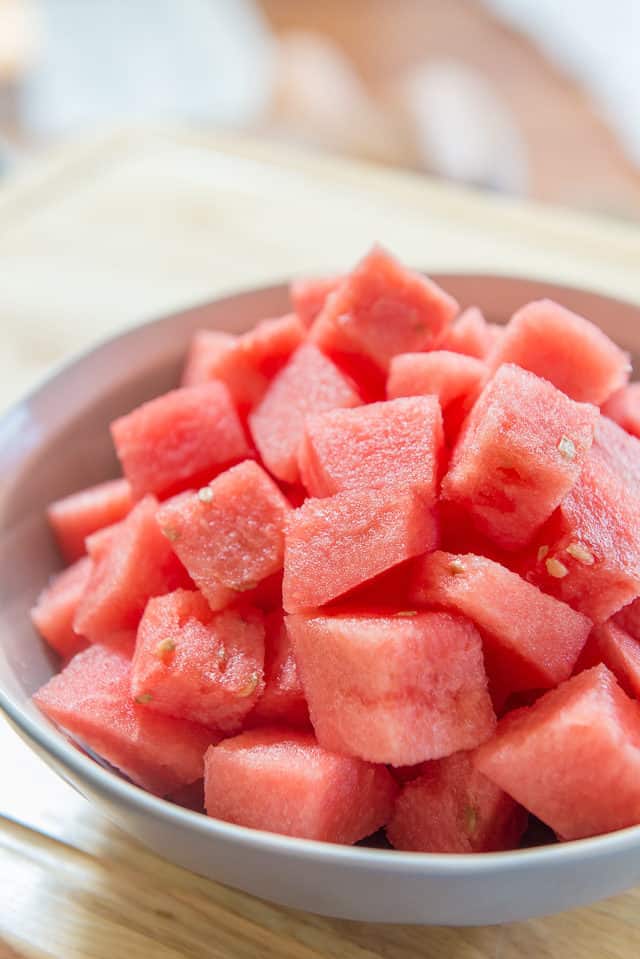
Just make sure to use a sharp knife so you get crisp pieces.
Click the photo above for my guide on cutting. Enjoy watermelon season!
More Tips and FAQ
If it’s cut, the watermelon must be stored in the fridge and can be kept in a large container for up to 5 days. An uncut watermelon can be kept at room temperature for a few days, but I find it’s best to get it into the fridge as quickly as possible, especially since watermelons do not ripen further on the counter.
Yes, but it’s not something you’ll want to eat again in a thawed state. I freeze watermelon to blend into a Watermelon Slushie or as ice cubes for Summer Drinks.
In the South they serve pickled watermelon rinds as a kind of relish, and it’s very good! I’ve never made it myself though. Only had it in restaurants.
Did you enjoy the recipe? Please leave a 5-star rating in the recipe card below and/or a review in the comments section further down the page. Or, follow me on Facebook, Instagram or Pinterest!
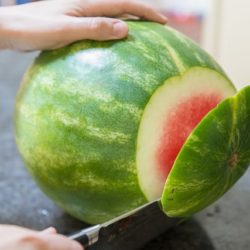
How to Pick a Good Watermelon
Ingredients
- 1 large watermelon
Instructions
- Find the Field Spot – Look for a deep yellow color. If there’s a white field spot, or no field spot at all, it likely won’t be good.
- Pick a Dull Looking Watermelon – A shiny appearance indicates an underripe melon.
- Knock on It with Your Knuckles – Your knuckles should bounce off the melon, and the surface should be pretty hard/firm. Soft flesh indicates it’s starting to spoil.
- Get the Heaviest One for Its Size – This applies to pretty much all produce, but you want to pick the watermelon that is the heaviest one for its size. That means there’s more water in it.
- Check for a Uniform Shape – Some watermelons are round, some are oval, and either is fine. But if there are irregular bumps, this indicates the melon may have gotten inconsistent amounts of sun or water.
- Look for the Sugar Spots and Pollination Points – If you see black spots on the melon, this is where sugar is seeping out and indicates a sweet melon. Also, if you see dots in a line (not a scratch), these are pollination points, and the more of them the better.
- If you want an easy way to cut the watermelon into sticks or cubes, see my How to Cut a Watermelon post. Enjoy!
Nutrition
Nutrition is estimated using a food database and is only intended to be used as a guideline for informational purposes.
Post updated with new photos and more tips in June 2018. Originally published April 2011.

288 Comments on “How To Pick A Good Watermelon”
A great treat is to cut the melon into bigger pieces and stick in a popsicle stick. My kids love to eat watermelon pops and they are much healthier!
In addition to rapping on the watermelon, I also look at the stem end to see how wrenched it is. If it looks very stubby or ripped, then I presume it wasn’t quite ready to be picked. I also look at the blossom end to see how much leaf or blossom is there. If there is still leaf or blossom attached, I also presume it wasn’t quite ready to be picked.
Hi Christine, thanks for sharing your tips! I will start looking at that when I pick out watermelons at the store =)
Thanks for share!!!!
My father-in-law used to pick melons as a youngin. He says to look for a ‘sticky butt’. If the stem end is a little sticky, it means the juices are trying to escape. Never has failed me!
This was awesome and it looks super easy! Thank you!!
You’re welcome, hope the tips help!
Hi Joanne,
Awesome tips here! I would never have thought to cut a watermelon like that – normally we just slice it off and eat it..lol. But, I like this alternative and will have to look for that watermelon rind recipe, sounds delish!
Thanks for sharing your tip and for the video!
Linda
Hi Linda, fantastic! I hope it comes handy this summer when all the in season watermelons come out!
Absolutely wash the melon. Farmers use fecal matter to fertilize their crops. Cow and horse poop. I would want to wash the melon first. Recent cases in Toronto, Ontario of hep B from store bought veg and fruits should be enough to make you want to wash everything .You wouldn’t put the shoes you wore to the melon patch in your fridge, so why would you put an unwashed melon in there? Or on your counter or cutting board?
I totally agree with ‘jan’. I live in a large farming area in the Southeastern U.S. where there are many pig and turkey farms in our area for national brands of meat. Years ago, most farmers would incorporate some type of dry manure fertilizers into the land as they planted crops. Many of these farms are now required to have lagoons for their animal waste, and they began to fertilize crops by spraying manure from these lagoons over their fields. This includes not only melons, but other produce as well, including soybeans and cotton. I’ve wondered if many of the E coli outbreaks may have been a result of not only the way produce is handled by farmworkers and/or various storage/shipping methods, but also just because of the fertilizing methods of spraying the land and plants from these lagoons. Unless you grow it yourself, it would pay to wash produce purchased from any public market or grocery store just to be on the safe side!
Gracias por la fantástica información, respecto a la desinfección de frutas y verduras, mi consejo es el siguiente, preparar, un cubo con agua, vinagre y bicarbonato de sodio, frotar y dejar en remojo, después aclarar y secar, sirve para todo tipo de frutas y verduras.
Bendiciones
We love your advice! It’s hard to find the perfect watermelon but your tips are very helpful. Thank you!
An easier way is just to quarter it and score it. That cubes it effortlessly. I do this for a living – I work in the fresh made section at the grocer.
Hey, just found you through Pinterest! Love the tips. I’m definitely going to be using them the next time I pick out a watermelon. Thank you.
PS: I too love spatulas 🙂
We cut our watermelon this way. However, we use an electric knife to do the job. It is so easy!
Hi Joanne,
Great post! I found you on Pinterest, and just wanted to say thanks for this! This is a much better way to cut a watermelon! I used to work at a produce stand in Dunnellon, FL, and we sold watermelon all through the summer. An easy way to remember what sound the watermelon should make when you thump it is to compare it to these sounds:
-Tap your forehead with your hand (high sound) —> underripe melon
-Tap your stomach with your hand (low, heavy sound) —> overripe melon
-Tap your chest with your hand (bouncy, solid sound) —> perfect melon
Erin!!!! That is ingenious! It is right on. I put in a number of posts about picking vaious melons on this site in case you want to check them out.
Thank you for the great tip!
Blessings
Neat! Thanks Erin!
I’m not a big fan of watermelon, but you can also use this cutting technique with other melons like cantaloupe. Slice in half, scoop out the seeds, flip so the flat side is down, and slice off the rind. You’re left with a little dome of fruit which can be sliced in half inch lines then one perpendicular cut across the middle.
Oh, and I totally agree about the washing thing. I’m less concerned about hand germs than I am about pesticides and animal droppings. I rinse everything before cutting. I even read somewhere that you shouldn’t drink water at a restaurant with a slice of lemon in it that still has the rind because you don’t know if the lemon was washed.
The warning about the lemons is more because they are never stored properly and bowls of lemon are often reused.
In addition to your wonderful advice, I was told by a produce worker, who use to grow watermelons in Durango, Mexico, to look for bee stings on the watermelon. It will look like trails of dry tracks on the skin of the watermelon. Bees will pick out the sweetest ones and do most of the work for you! Thanks.
CoCoinBonita
Thanks for sharing a great tip with us! Others have mentioned the bee stings and I have started to notice them now that I know they are there.
Thanks for the advice! I will def try cutting mine like that next time.
A deep solid thump with a bit of vibration will give you a delicious watermelon. We grow them every year and haven’t had a bad one yet, testing them this way. Also, the girl in the video would have an easier time, if she used a longer narrower knife.